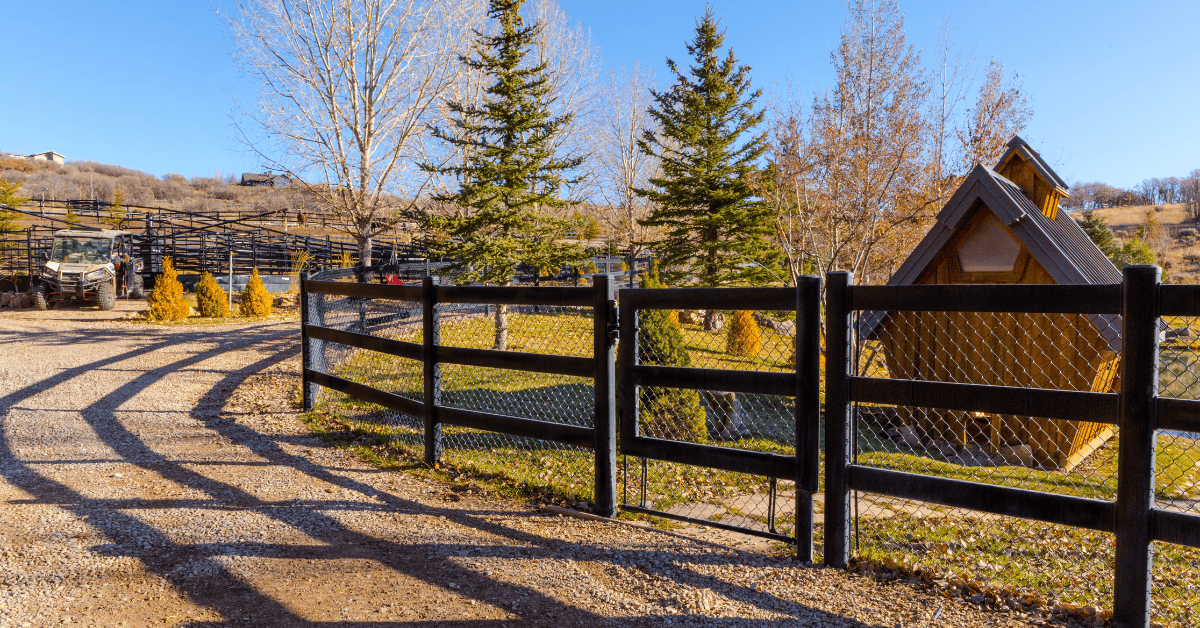If you’ve ever walked out to find livestock killed or injured from a coyote attack, you understand that sick feeling in your gut. It’s not just the economic loss…though that’s real enough. It’s knowing those animals depended on you for protection, and something got through.
Coyotes are smart, persistent, and always hungry. They’re not just passing through. They’re actively hunting your property, testing every weak point in your defense. A single gap or design flaw is all they need. That’s why most so-called “coyote-proof” fencing fails within the first year.
It’s not built with a true understanding of what you’re up against.
We’ve spent decades listening to ranchers and horse owners describe what works and what doesn’t when it comes to keeping predators out. We’ve learned that effective coyote protection isn’t about a single silver-bullet solution. It’s about building a complete system where every component addresses a specific threat behavior.
The right type of fence combines appropriate height to prevent jumping, ground barriers to stop digging, proper materials to resist chewing and climbing, and (most importantly) specially designed components that eliminate the weak points coyotes inevitably find.
When these elements work together, you create something that actually deserves to be called coyote-proof.
This isn’t about overbuilding or spending more than necessary. It’s about understanding the actual problem and addressing it intelligently, with proven solutions. Because when it comes to protecting your livestock, doing it right the first time isn’t just more effective—it’s ultimately less expensive than repeatedly fixing failures.
Quick Explainer to Typical Coyote Behavior
The best defense starts with understanding what you’re up against. Coyotes aren’t just opportunistic. They’re methodical predators with specific behaviors you need to counter.
Coyotes can jump fences up to 6 feet high, dig down 12-18 inches when motivated, and exploit even small gaps or weak points. They’ll patrol your fence line repeatedly, testing different sections until finding vulnerability. Most attacks occur at dawn or dusk when visibility is poor.
Unlike some predators, coyotes learn and adapt. If one approach fails, they’ll try another. They’re particularly adept at finding ways under gates or through connections between different fence types. Once they succeed, they’ll return to the same entry point repeatedly.
Perhaps most importantly, coyotes aren’t easily discouraged by simple deterrents. They calculate risk versus reward, and if hungry enough, will brave major obstacles to reach livestock. Well, unless your fence system creates a truly comprehensive barrier.
Must-Have Components of Coyote-Proof Fencing
Building a coyote-proof fence is about combining the right elements into a system that addresses every potential vulnerability. After years of field testing and customer feedback, we’ve found these essential components for fencing that actually keeps coyotes out:
- Proper Height: Minimum 5’6″ fence height prevents jumping.
- Underground Barrier: At least 12″ of fence material buried in an L-shape extending outward prevents determined digging under your fence line.
- Appropriate Mesh Size: 2″ x 4″ wire mesh or smaller prevents young coyotes from squeezing through openings while maintaining visibility.
- Quality Base Fence: Steel board fencing provides the structural integrity and visual barrier that deters initial approach and prevents climbing.
- Wire Mesh Attachment System: Properly secured mesh using Buckley Wire Mesh Clips prevents sagging and creates a unified barrier without damaging your fence’s protective coating.
- Gate Protection: Boomerang Brackets and extended mesh eliminates the under-gate vulnerability that coyotes frequently exploit.
- Corner Reinforcement: Additional protection at corner posts prevents exploitation of the natural weak points in your perimeter.
- Secure Connections: Proper transitions between fence types and at property boundaries eliminates gaps that become entry points.
Base Fence Selection: Starting with the Right Foundation
Your coyote defense system begins with choosing a base fence that won’t compromise when tested. While wire mesh creates your barrier against predators, it needs a proper backbone to stand strong season after season.
Steel board fencing is the foundation serious ranchers choose when failure isn’t an option. Unlike wood that warps and creates gaps after the first hard rain, or vinyl that flexes when a coyote leans into it, our galvanized steel board system holds its line without flinching. Those solid horizontal rails do double duty: they establish a visible boundary that makes predators think twice while giving you perfect attachment points for wire mesh using our specialized clips.
For those of us with horses or livestock, this approach makes plain sense. You’re getting premium containment for your animals while creating the structure needed for predator protection.
One fence, two jobs, no compromise.
Don’t overlook your posts. Our steel posts, set properly in concrete (24-30″ deep depending on your soil), provide the no-nonsense support needed to keep your fence tight even when tested. This foundation guarantees your entire system works as intended, without the sagging or ground-level gaps that might as well be welcome mats for hungry coyotes.
Wire Mesh Integration
Your steel board fence provides the framework, but proper wire mesh integration is what transforms it into a genuine coyote barrier. This isn’t just about hanging some wire and hoping for the best—it’s about creating a defensive layer that addresses specific predator behaviors.
- Mesh Selection: Don’t cut corners here. You need 14-gauge minimum, 2″ x 4″ openings or smaller. Vinyl-coated mesh in black not only looks better with our fencing, it lasts longer and prevents injuries to your livestock. This isn’t the place to save a few dollars. Cheaper mesh means replacing your entire system sooner.
- Attachment Method: Our Wire Mesh Clips are designed to secure mesh to steel board fencing without damaging the powder-coated finish. Unlike makeshift solutions that create rust points or work loose over time, these clips maintain consistent tension across the entire fence line. The self-sealing rubber well nut creates a weatherproof seal that preserves your fence’s integrity.
- Complete Coverage: Mesh should extend from a minimum of 12″ underground up to the full height of your fence. The underground portion should angle outward at 90 degrees, forming an “L” shape that defeats digging attempts. This isn’t excessive—it’s what actually works against determined predators.
- Gate Integration: Gates are typically the first point of failure in predator fencing. Boomerang Brackets allow you to extend mesh protection beneath gates, eliminating the vulnerable gap that coyotes quickly identify and exploit. This system creates a continuous barrier while still allowing normal gate operation.
Remember, coyotes need to find just one weakness to make your entire investment worthless.
Invest Once, Protect Forever
Coyotes don’t care how much your fence cost or what the salesman promised. They care about one thing: finding a way through to your livestock. And they’ve got nothing but time to figure it out.
We’ve seen too many properties where good animals were lost because someone thought “good enough” actually was. It never is. Not with predators this determined.
At Buckley, we don’t build fence systems based on theory or what looks good in a catalog. We build what works after decades of watching what fails. Our steel board fencing paired with proper mesh integration isn’t just another option: it’s what serious ranchers choose when they’re tired of finding dead stock in the morning.
Yes, doing it right costs more upfront. So does a good rifle or a reliable truck. But some things you only want to buy once. When you calculate what you’ve invested in your animals and what you stand to lose, the decision gets pretty straightforward.
Ready to put this problem behind you for good? Send us a message. We’ll help you build something that stands between your livestock and those predators for the long haul.
Because on your land, you make the rules: not the coyotes.



